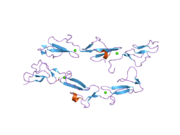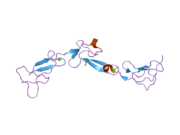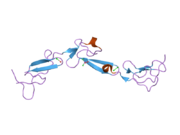CD97
Template:PBB CD97 antigen is a protein that in humans is encoded by the CD97 gene.[1][2][3]
This gene encodes a member of the adhesion-GPCR receptor family [4] expressed predominantly by cells of the immune system. Family members are characterized by an extended extracellular region with a variable number of N-terminal protein modules coupled to a TM7 region via a domain known as the GPCR-Autoproteolysis INducing (GAIN) domain.[5] In the case of CD97 the N-terminal domains consist of alternatively spliced epidermal growth factor (EGF)-like domains. These mediate binding to its cellular ligand, decay accelerating factor (DAF/CD55), a regulatory protein of the complement cascade, however the CD55-CD97 interaction is believed to have an activity independent of complement. Alternative splicing has been observed for this gene and three variants have been found.[3]
CD97 is an adhesion GPCR that is normally found on tissue of hematapoetic origin and in smooth muscle.[6] It signals through Gα12/13 and activates RHO. It has been found to be upregulated in Cancers, including prostate, breast, and thyroid. In prostate cancer. it has been shown that CD97 is hetoerodimerizing with another GPCR, LPAR. The interaction is believed to further enhance the RHO signaling between both receptors.[7]
References
- ^ Hamann J, Eichler W, Hamann D, Kerstens HM, Poddighe PJ, Hoovers JM, Hartmann E, Strauss M, van Lier RA (Sep 1995). "Expression cloning and chromosomal mapping of the leukocyte activation antigen CD97, a new seven-span transmembrane molecule of the secretion receptor superfamily with an unusual extracellular domain". J Immunol. 155 (4): 1942–50. PMID 7636245.
{{cite journal}}: CS1 maint: multiple names: authors list (link) - ^ Hamann J, Hartmann E, van Lier RA (Sep 1996). "Structure of the human CD97 gene: exon shuffling has generated a new type of seven-span transmembrane molecule related to the secretin receptor superfamily". Genomics. 32 (1): 144–7. doi:10.1006/geno.1996.0092. PMID 8786105.
{{cite journal}}: CS1 maint: multiple names: authors list (link) - ^ a b "Entrez Gene: CD97 CD97 molecule".
- ^ Stacey M, Yona S (2011). Adhesion-GPCRs: Structure to Function (Advances in Experimental Medicine and Biology). Berlin: Springer. ISBN 1-4419-7912-3.
- ^ Araç D, Boucard AA, Bolliger MF, Nguyen J, Soltis SM, Südhof TC, Brunger AT (March 2012). "A novel evolutionarily conserved domain of cell-adhesion GPCRs mediates autoproteolysis". EMBO J. 31 (6): 1364–78. doi:10.1038/emboj.2012.26. PMC 3321182. PMID 22333914.
{{cite journal}}: CS1 maint: multiple names: authors list (link) - ^ Ward, Y., R. Lake, J. J. Yin, C. D. Heger, M. Raffeld, P. K. Goldsmith, M. Merino, K. Kelly. 2011. LPA receptor heterodimerizes with CD97 to amplify LPA-initiated RHO-dependent signaling and invasion in prostate cancer cells" Cancer Res 71: 7301–7311.
- ^ Ward Y, Lake R, Martin P L, Killian K, Salerno P, Wang T, Meltzer P, Merino M, Cheng S-Y, Santoro M, Garcia-Rostan G, Kelly K,CD97 amplifies LPA receptor signaling and promotes thyroid cancer progression in a mouse model. Oncogene. 2012/07/16/online
External Links



